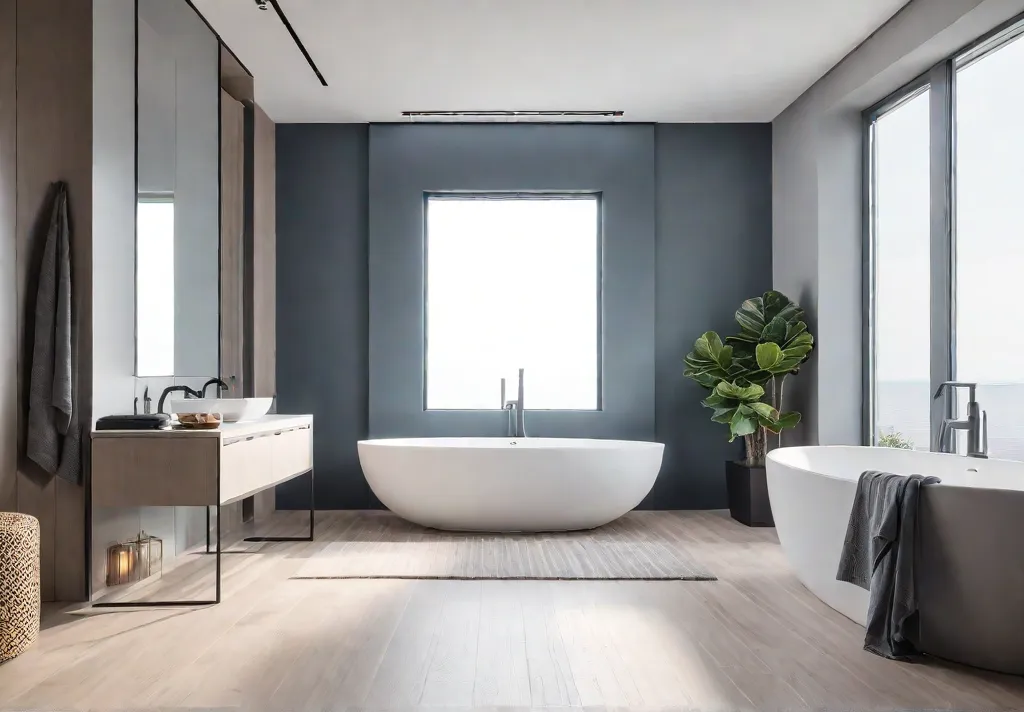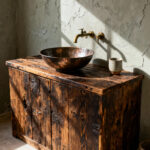As a seasoned contractor, I’ve witnessed firsthand how transforming a small bathroom can be a game-changer for homeowners. While compact spaces may seem limiting, the right design choices can create a sense of openness and serenity that belies the room’s actual size. In this article, I’ll share my insider tips on flooring options that can visually expand even the tiniest of bathrooms.
From light-colored tiles that reflect natural illumination to large-format designs that minimize visual breaks, we’ll explore practical yet stylish solutions that pack a punch. I’ll also reveal the power of geometric patterns to create depth and movement, as well as the versatility of vinyl flooring – a durable and budget-friendly option that can mimic high-end materials.

Whether you’re planning a full renovation or a simple refresh, these flooring ideas will inspire you to think beyond the confines of your small bathroom. So, let’s dive in and unlock the secrets to maximizing space and elevating your sanctuary’s style.
The Power of Light Colored Flooring
As someone who values the harmony between aesthetics and functionality, I can’t emphasize enough the transformative impact of light-colored flooring in small bathrooms. These spaces often suffer from a lack of natural illumination, but with the right flooring choice, you can create an airy, open ambiance that defies the room’s compact dimensions.

Choosing the Right Shade
When it comes to selecting the perfect light hue for your bathroom floor, the options are plentiful. Soft whites, creamy ivories, and delicate grays are all excellent choices that reflect up to 80% of available light, instantly brightening the space. If you’re feeling a bit more adventurous, consider pastel shades like pale blues or muted greens, which can add a touch of serenity without overwhelming the room.
Pairing Light Flooring with Wall Colors
To truly maximize the effect of light-colored flooring, it’s essential to complement it with similarly toned walls. A seamless transition from floor to walls creates a sense of continuity, making the space feel larger and more cohesive. However, that doesn’t mean you have to sacrifice personality – feel free to inject pops of color through towels, rugs, and accessories, which will add depth and character without compromising the overall airy ambiance.
One of the most practical light-colored flooring options for high-moisture areas like bathrooms is ceramic or porcelain tile. These materials are not only water-resistant but also incredibly durable, ensuring your flooring can withstand the daily wear and tear of a busy household. If you’re looking for a warmer, more natural feel, consider light-toned wood-look luxury vinyl planks or tiles, which offer the aesthetic appeal of hardwood without maintenance concerns.

In essence, light-colored flooring is a simple yet effective way to visually expand a small bathroom, creating a sense of openness and tranquility. By thoughtfully selecting the right shade and pairing it with complementary wall colors, you can transform even the most compact space into a serene oasis that invites relaxation and rejuvenation.
Maximizing Space with Large Format Tiles
When it comes to small bathrooms, every square inch counts. That’s why I often recommend using large format tiles for the flooring. These oversized tiles create fewer grout lines, resulting in a more seamless and continuous look that can visually expand the space.

Choosing the Right Tile Size
The key is to opt for tiles that are at least 12×12 inches or larger. The fewer grout lines you have, the fewer visual breaks there are on the floor, creating a sense of openness. I’ve found that rectangular tiles installed horizontally can be particularly effective in widening the appearance of a narrow bathroom.
Grout Color Considerations
Grout color plays a crucial role in achieving that seamless look. I always advise my clients to choose a grout shade that closely matches the tile color. This minimizes the contrast between the tiles and grout lines, further enhancing the illusion of a larger, uninterrupted floor space.
Now, let’s talk tile materials. Here are a few pros and cons to consider:
- Porcelain: Durable, low-maintenance, and available in a wide range of styles. However, it can be more expensive than other options.
- Ceramic: Budget-friendly and easy to install, but not as durable as porcelain.
- Natural Stone: Adds warmth and luxury, but requires more maintenance and can be slippery when wet.

Regardless of the material you choose, large-format tiles are a strategic choice for creating the illusion of a larger floor space in a small bathroom. They seamlessly blend functionality and style, maximizing every inch of your cozy sanctuary.
As you plan your bathroom renovation, keep in mind that the right flooring can make a world of difference in how the space is perceived. By thoughtfully selecting large format tiles and grout colors, you can create an inviting, open atmosphere that defies the room’s compact dimensions.
Creating Illusion of Spaciousness with Geometric Patterns
As a contractor with an eye for detail, I’ve learned that strategic use of geometric patterns can be a game-changer for small bathrooms. These intricate designs have the power to create an illusion of depth and movement, instantly making the space feel more expansive and visually captivating.

Types of Geometric Patterns
When it comes to geometric patterns, the possibilities are endless. From classic herringbone to modern hexagons, each pattern brings its unique character to the space. I’m a fan of chevron and basketweave designs – they add a touch of playfulness while still maintaining a sense of sophistication.
Here are a few of my favorite geometric patterns to consider:
- Herringbone: This timeless pattern has been used in design for centuries, and good reason. Its zigzag pattern creates a sense of movement that can make a small bathroom feel more dynamic.
- Hexagons: Hexagonal tiles offer a modern twist on geometric patterns. Their honeycomb-like arrangement adds visual interest and can create the illusion of depth.
- Chevron: Similar to herringbone, chevron patterns feature a bold, zigzag design that can make a space feel more expansive.
- Basketweave: This intricate pattern resembles the weave of a basket, adding texture and dimension to your bathroom floor.

Scale and Placement
When working with geometric patterns in a small bathroom, scale and placement are crucial. While larger patterns can make a bold statement, they should be used sparingly to avoid overwhelming the space.
I recommend exploring smaller-scale patterns or using larger patterns as accents, such as a border or a feature wall. This way, you can add visual interest without compromising the sense of openness.
Another approach is to create a statement floor with a bold geometric pattern, but balance it out with simpler wall and fixture choices. This allows the floor to be the focal point while maintaining a cohesive and harmonious overall design.

Remember, the key to using geometric patterns in a small bathroom is to strike a balance between visual interest and a sense of spaciousness. By carefully considering the scale and placement of these patterns, you can create a space that feels both visually dynamic and comfortable.
As we move on to the next section, I’ll share insights on the versatility and durability of vinyl flooring, a practical and stylish option for tiny bathrooms.
The Versatility and Durability of Vinyl Flooring
As a contractor who has tackled numerous bathroom renovations, I’ve come to appreciate the versatility and durability of vinyl flooring. In the realm of small bathrooms, where every square inch counts, vinyl offers a practical and stylish solution that can transform these compact spaces into functional and visually appealing sanctuaries.

Types of Vinyl Flooring
When it comes to vinyl flooring, homeowners have a variety of options to choose from:
- Sheet Vinyl: This traditional option offers a seamless, waterproof surface that can be installed quickly and easily.
- Vinyl Tile: Available in individual tiles, this option allows for more customization and pattern variations.
- Luxury Vinyl Plank (LVP): Designed to mimic the look of hardwood or natural stone, LVP flooring provides a high-end aesthetic at a fraction of the cost.
Design Options for Small Bathrooms
One of the biggest advantages of vinyl flooring is its ability to cater to various design preferences. For small bathrooms, I often recommend:
- Light Colors: Opt for lighter shades to create an illusion of spaciousness and reflect natural light.
- Subtle Patterns: A subtle pattern or wood-look vinyl can add visual interest without overwhelming the space.
- Plank Styles: Vinyl planks laid in a horizontal or diagonal pattern can make a small bathroom appear larger.

An interesting fact about luxury vinyl plank flooring is its ability to realistically mimic the look of hardwood or natural stone, providing a high-end aesthetic without the associated maintenance and cost. This makes it an excellent choice for homeowners seeking a premium look within a budget.
When it comes to installation, proper preparation and attention to detail are crucial. I always ensure that the subfloor is level, clean, and free of any moisture before laying the vinyl flooring. This preventative measure helps to avoid future issues such as buckling or water damage.
With the latest advancements in vinyl flooring technology, manufacturers are continuously improving the product’s durability, water resistance, and ease of maintenance. This makes vinyl an ideal choice for high-traffic areas like bathrooms, where spills and moisture are common occurrences.
In summary, vinyl flooring offers a practical and stylish solution for small bathrooms, providing durability and design versatility. By carefully considering the type of vinyl, color, pattern, and installation method, homeowners can create a space that not only looks beautiful but also withstands the demands of daily use.

Choosing the Right Size of Rug
When it comes to bathroom decor, rugs often get overlooked. But in a small space, they can be a game-changer, adding warmth, texture, and a pop of color. The key is finding the right size rug to avoid a cramped, cluttered look. Trust me, I’ve made the mistake of going too big before – it’s not a good look.
Sizing Guide for Bathroom Rugs
As a general rule, you’ll want a rug that’s just large enough to anchor the space without overwhelming it. Here are some sizing guidelines to keep in mind:
- For a standard-sized sink, a 2×3 foot rug is usually a safe bet.
- In front of a bathtub or shower, a runner rug (around 2×5 feet) can work nicely.
- If you have a pedestal sink or a tiny bathroom, consider a petite 1.5×2 foot rug.
The key is leaving enough floor space around the edges for easy movement and cleaning.

Placement Strategies
Proper placement can make a small rug look intentional and visually expand the space. Here are some tips:
- Place the rug in front of the sink or bathtub to anchor that area.
- Align the rug parallel to the fixtures for a clean, organized look.
- Leave at least 6 inches of floor space around the edges of the rug.
- In a tight space, you might need to get creative – a rug positioned diagonally can open things up.
Interesting Fact
Did you know that a small rug placed strategically can make a room feel larger by defining a specific area? It’s all about creating zones and drawing the eye.
Practical Tips
- For a cohesive look, coordinate the rug with your bathroom’s color scheme and flooring style.
- Low-pile rugs are easier to clean and less likely to trap moisture.
- Use a rug pad to prevent slipping and extend the life of your rug.

Design Tips for Coordinating Rugs with Flooring
- For tile floors, consider a rug with a subtle pattern or texture to add visual interest.
- With wood floors, a plush, high-pile rug can add warmth and coziness.
- For a sleek, modern look, pair a solid-colored rug with patterned tile or bold flooring.
Remember, the right size and placement of a bathroom rug can significantly impact the overall look and feel of your small space. With a little planning, you can create a stylish and functional oasis.
Up next, we’ll wrap things up with some final thoughts on maximizing your tiny bathroom’s potential.
Wrapping Up
As you embark on your small bathroom renovation journey, remember that the right flooring choice can be a transformative element. By embracing light colors, large-format tiles, geometric patterns, or the versatility of vinyl, you can create an illusion of spaciousness that defies the room’s compact dimensions.

But beyond just visual trickery, these flooring options offer practical benefits as well – from durability and water resistance to easy maintenance and a range of design possibilities. Trust me, when you step into your newly renovated bathroom, you’ll be amazed at how much bigger and more inviting it feels.
So, don’t let a tiny bathroom hold you back from achieving your dream sanctuary. With a little creativity and the right flooring selection, you can turn a once-cramped space into a serene oasis that inspires relaxation and rejuvenation. Embrace the challenge, and let your small bathroom make a big impact on your daily routine and overall well-being.






